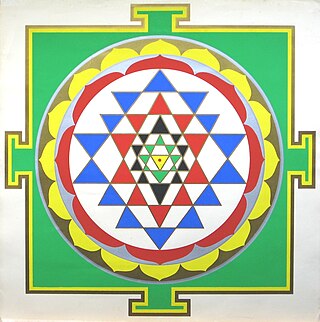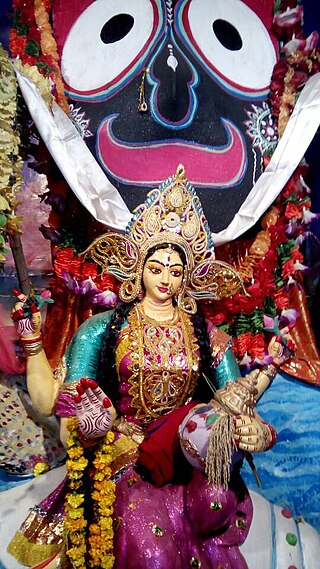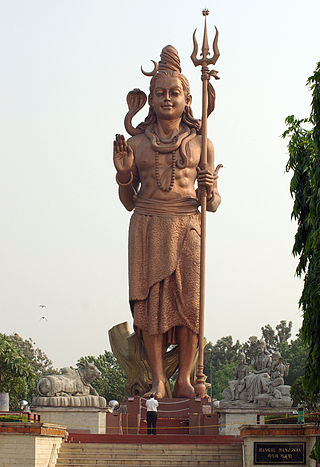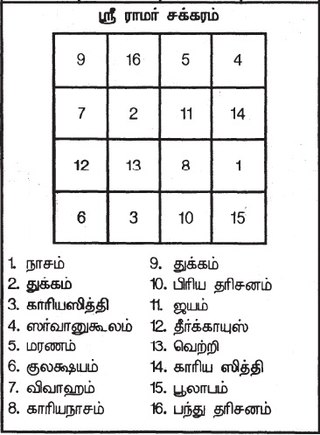
In recreational mathematics, a square array of numbers, usually positive integers, is called a magic square if the sums of the numbers in each row, each column, and both main diagonals are the same. The 'order' of the magic square is the number of integers along one side (n), and the constant sum is called the 'magic constant'. If the array includes just the positive integers , the magic square is said to be 'normal'. Some authors take magic square to mean normal magic square.

In geometry, straightedge-and-compass construction – also known as ruler-and-compass construction, Euclidean construction, or classical construction – is the construction of lengths, angles, and other geometric figures using only an idealized ruler and a pair of compasses.

Kubera also known as Kuvera, Kuber and Kuberan, is the god of wealth, and the god-king of the semi-divine yakshas in Hinduism. He is regarded as the regent of the north (Dikpala), and a protector of the world (Lokapala). His many epithets extol him as the overlord of numerous semi-divine species, and the owner of the treasures of the world. Kubera is often depicted with a plump body, adorned with jewels, and carrying a money-pot and a club.

Daniel Gerhard Brown is an American author best known for his thriller novels, including the Robert Langdon novels Angels & Demons (2000), The Da Vinci Code (2003), The Lost Symbol (2009), Inferno (2013), and Origin (2017). His novels are treasure hunts that usually take place over a period of 24 hours. They feature recurring themes of cryptography, art, and conspiracy theories. His books have been translated into 57 languages and, as of 2012, have sold over 200 million copies. Three of them, Angels & Demons, The Da Vinci Code, and Inferno, have been adapted into films, while one of them, The Lost Symbol, was adapted into a television show.
In combinatorial mathematics, two Latin squares of the same size (order) are said to be orthogonal if when superimposed the ordered paired entries in the positions are all distinct. A set of Latin squares, all of the same order, all pairs of which are orthogonal is called a set of mutually orthogonal Latin squares. This concept of orthogonality in combinatorics is strongly related to the concept of blocking in statistics, which ensures that independent variables are truly independent with no hidden confounding correlations. "Orthogonal" is thus synonymous with "independent" in that knowing one variable's value gives no further information about another variable's likely value.

Rangoli is an art form that originates from in the Indian subcontinent, in which patterns are created on the floor or a tabletop using materials such as powdered lime stone, red ochre, dry rice flour, coloured sand, quartz powder, flower petals, and coloured rocks. It is an everyday practice in many Hindu households, however making it is mostly reserved for festivals and other important celebrations as it is time consuming. Rangolis are usually made during Diwali or Tihar, Onam, Pongal, and other Hindu festivals in the Indian subcontinent, and are most often made during Diwali. Designs are passed from one generation to the next, keeping both the art form and the tradition alive.

A magic circle is a circle of space marked out by practitioners of some branches of ritual magic, which they generally believe will contain energy and form a sacred space, or will provide them a form of magical protection, or both. It may be marked physically, drawn in a material like salt, flour, or chalk, or merely visualised.

Kolam, also known as Muggu, Tarai Alangaram and Rangoli is a form of traditional decorative art that is drawn by using rice flour as per age-old conventions. It is also drawn using white stone powder, chalk or chalk powder, often along with natural or synthetic color powders. Its origin belongs to the ancient Tamil Nadu known as Tamilakam and has since spread to the other southern Indian states of Karnataka, Telangana, Andhra Pradesh, and Kerala. It can be found in some parts of Goa and Maharashtra. Since the Tamil diaspora is worldwide, the practice of kolam is found around the world, including in Sri Lanka, Singapore, Malaysia, Indonesia, Thailand and a few other Asian countries. A kolam or muggu is a geometrical line drawing composed of straight lines, curves and loops, drawn around a grid pattern of dots. It is widely practised by female family members in front of their house entrance, although men and boys also practice this tradition. The similar regional versions of kolam with their own distinctive forms are known by different names in India: raangolee in Maharashtra, aripan in Mithila, alpona in West Bengal and hase and rangoli in Kannada in Karnataka. More complex kolams are drawn and colors are often added during festival days, holiday occasions and special events.

The Lost Symbol is a 2009 novel written by American writer Dan Brown. It is a thriller set in Washington, D.C., after the events of The Da Vinci Code, and relies on Freemasonry for both its recurring theme and its major characters.
Combinatorial design theory is the part of combinatorial mathematics that deals with the existence, construction and properties of systems of finite sets whose arrangements satisfy generalized concepts of balance and/or symmetry. These concepts are not made precise so that a wide range of objects can be thought of as being under the same umbrella. At times this might involve the numerical sizes of set intersections as in block designs, while at other times it could involve the spatial arrangement of entries in an array as in sudoku grids.

Yantra (यन्त्र) is a geometrical diagram, mainly from the Tantric traditions of the Indian religions. Yantras are used for the worship of deities in temples or at home; as an aid in meditation; used for the benefits given by their supposed occult powers based on Hindu astrology and tantric texts. They are also used for adornment of temple floors, due mainly to their aesthetic and symmetric qualities. Specific yantras are traditionally associated with specific deities and/or certain types of energies used for accomplishment of certain tasks, vows, that may be materialistic or spiritual in nature. It becomes a prime tool in certain sadhanas performed by the sadhaka the spiritual seeker. Yantras hold great importance in Hinduism, Jainism, and Buddhism.

Ghost leg is a method of lottery designed to create random pairings between two sets of any number of things, as long as the number of elements in each set is the same. This is often used to distribute things among people, where the number of things distributed is the same as the number of people. For instance, chores or prizes could be assigned fairly and randomly this way.

Lakshmi Puja is a Hindu occasion for the veneration of Lakshmi, the goddess of prosperity and the supreme goddess of Vaishnavism. The occasion is celebrated on the amavasya in the Vikram Samvat Hindu calendar month of Ashwayuja or Kartika, on the third day of Deepavali (Tihar) in most part of India and Nepal. In Assam, Bengal, and Odisha, this puja is celebrated five days after Vijaya Dashami.

Alpana or alpona is a South Asian folk art style, traditionally practiced by women, and consisting of colored motifs, patterns, and symbols that are painted on floors and walls with paints made from rice flour, on religious occasions. It is common to the Bengal region in India, and in Bangladesh. Amongst Hindu families, alpanas may contain religious motifs with symbolic designs that relate to religious austerity, festivals, and specific deities. Amongst Santal tribal communities, alpanas often contain geometric or symbolic patterns drawn from nature. Although traditionally the domain of rural women, Alpana motifs have been very influential in modern Indian art, and are incorporated into the works of artists such as Jamini Roy, Abanindranath Tagore, Devi Prasad, and in the early illustrations of film-maker Satyajit Ray. In contemporary Bengal, alpanas are created as part of religious festivals such as the Durga puja, in public and private spaces.
Mattu Pongal is the third day of the four-day Pongal festival. According to the Gregorian calendar it is celebrated on 16 January. Though the name of the festival is specific to Tamil Nadu, it is also celebrated in other southern Indian states such as Andhra Pradesh and Karnataka. Makar Sankranti is a festival that marks the start of northern declination of the Sun from the Zodiac sign of Sagittarius to Capricorn, which according to Tamil calendar usually falls on 14 January.

The trishula is a trident, a divine symbol, commonly used as one of the principal symbols in Hinduism. It is most commonly associated with the deity Shiva and widely employed in his iconography.

Sriramachakra is a mystic diagram or a yantra given in Tamil almanacs as an instrument of astrology for predicting one's future. The geometrical diagram consists of a square divided into smaller squares by equal numbers of lines parallel to the sides of the square. Certain integers in well defined patterns are written in the various smaller squares. In some almanacs, for example, in the Panchangam published by the Sringeri Sharada Peetham or the Pnachangam published by Srirangam Temple, the diagram takes the form of a magic square of order 4 with certain special properties. This magic square belongs to a certain class of magic squares called strongly magic squares which has been so named and studied by T V Padmakumar, an amateur mathematician from Thiruvananthapuram, Kerala. In some almanacs, for example, in the Pambu Panchangam, the diagram consists of an arrangement of 36 small squares in 6 rows and 6 columns in which the digits 1, 2, ..., 9 are written in that order from left to right starting from the top-left corner, repeating the digits in the same direction once the digit 9 is reached.
Kolapodi is a type of flour, made out of soapstone powder, rice flour mixed with limestone powder,a type of red soil and finely ground white stone powder. It is used to create floor art in India called kolam. It can be used to make beautiful patterns in front of the house gate, in front of temples and in Pooja room.

Chowk-poorana or Chowkpurana is folk art practised in Punjab, Haryana, Himachal Pradesh, Madhya Pradesh and Uttar Pradesh. In Uttar Pradesh, the term chowk-poorana refers to decorating the floor with various designs using flour and rice and also the walls using designs specific to the region.
















